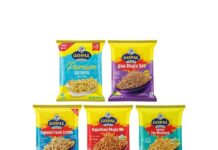
The new rotary Aseptic Blow Fill technology from GEA (ABF 2.0) offers beverage manufacturers with maximum hygiene and food safety and top performance in terms of filling speed, accuracy, and flexibility.
ABF 2.0 is suitable for the filling of shelf-stable, sensitive beverages, and milk-based drinks, using H2O2 for the sterilization of PET preforms. With the ABF 2.0, GEA has used all its experience to optimize Total Cost of Ownership (TCO) while enhancing the control of key parameters to eliminate any potential risk to the product. The ABF 2.0 can fill a full range of sensitive beverages, including still, clear drinks with or without particles, and carbonated drinks – high or low acid.
In the 1990s, when the aseptic systems were enclosed in large white rooms to fill in a sterile environment, GEA launched in the market an innovative way to confine and minimize the air volume to be kept in aseptic conditions around the filler and so to protect the product: the Microbiological Isolator. With the ABF technology launched back in 2010 GEA has confined inside the Microbiological Isolator also the aseptic Stretch Blow molder, thus forming together with the filler and capper module a state of the art system for product protection with no compromises and providing numerous benefits to users including reduced bottle weight, the option to develop increasingly complex and attractive bottle designs and allowing for the elimination of air conveyors, bottle sterilization and rinsing turrets. The whole system resulted in more compact than traditional aseptic technology and required fewer operators.
New features for efficiency and control
The new ABF 2.0 is an evolution from the original that includes many mechanical improvements and simplifications. These reduce power consumption while eliminating any potential risk of contamination by ensuring that every step of the sterilization process is carefully planned, controlled, and properly managed. Every process parameter and critical point is carefully monitored and traced to ensure reliable and repeatable sterilization performance. As an additional guarantee of reliable and efficient sterilization treatment, a Smart Sensor monitors spraying performance at each sterilization nozzle. This helps to ensure the safety and quality of the final product, with the speed, accuracy, and flexibility customers want.
The ABF 2.0 represents state-of-the-art in the aseptic technology market, especially for the highest sensitive products when it comes to food and product safety assurance throughout the lifecycle of a machine. To guarantee a thoroughly reliable and aseptic process, it is of the utmost importance to have a fully automated monitoring of the entire running operations, leaving no space at all to semi-automatic or manual procedures. Gea states that this is exactly the concept behind the GEA ABF 2.0.

Unlike the original machine, the preform does not need to be turned along with the transfer to the aseptic blower: this saves time and reduces maintenance costs. A new oven with optimized materials allowed to have fewer heating modules, this has achieved a significant reduction in power usage and the overall oven footprint. The blowing module’s introduction of an air recovery system has reduced power usage in that area as well. These innovations combine to provide users with a noticeable reduction in TCO.

The aseptic blowing wheel is located within the sterile zone with the filling and capping processes. This means that the sterile container does not leave the sterile area until the filling and capping is complete. This rigorous aseptic process ensures that the environmental contamination level is always under control.
The bottle caps are sterilized using Sterilcap VHP R from GEA. This technology claims to offer gentle sterilization treatment at reduced temperatures to avoid overheating the caps and includes a buffer to optimize the Overall Equipment Effectiveness (OEE) of the line.
Flexibility
Most bottling plants handle a wide variety of products, so GEA has designed the format changeover system on the ABF 2.0 to be fast and simple. This has claimed to enhance the flexibility of machines so that it appeals to the widest range of customers, especially those with multiple products. As companies work to achieve market share and product variety, the flexibility of plant operations is vitally important. ABF 2.0 provides the versatility and control that they need.
The environmental cleaning and sterilization processes are entirely automated and performed via a control panel without any manual manipulation from operators, that can represent a potential risk of contamination.
GEA offers FDA approved filling solutions for both PAA and H2O2-based applications. According to Gea, the evolution of a consolidated, FDA-validated platform, the ABF 2.0 is ready to meet all FDA regulations, which represent one of the most stringent protocols.
IndiFoodBev — authentic, impactful and influential
An English-language food and beverage processing and packaging industry B2B platform in print and web, IndiFoodBev is in its third year of publication. It is said that the Indian food and beverage industries represent approximately US$ 900 billion in revenues which implies more than 20% of the country’s GDP. Eliminating the wastage on the farmside can help to deliver more protein to a higher number of the population apart from generating sizable exports. The savings in soil, seeds, water, fertilizer, energy and ultimately food and nutrition could be the most immense contribution that country is poised to make to the moderation of climate change.
To improve your marketing and grow sales to the food and beverage processing and packaging industry, talk to us. Our research and consulting company IppStar [www.ippstar.org] can assess your potential and addressable markets in light of the competition. We can discuss marketing, communication, and sales strategies for market entry and growth.
Suppliers and service providers with a strategy and budget for targeted marketing can discuss using our hybrid print, web, video, and social media channels to create brand recognition linked to market relevance. Our technical writers are ready to meet you and your customers for content.
The second largest producer of fruit and vegetables in the world is continuously expanding processing capacities and delivery systems with appropriate innovative technologies. We cover product and consumer trends, nutrition, processing, research, equipment and packaging from farm to thali. Get our 2025 media kit and recalibrate your role in this dynamic market. Enhance your visibility and relevance to existing markets and turn potential customers into conversations. Ask for a sample copy of our bi-monthly in print or our weekly IndiFoodBev eZine each Wednesday.
For editorial info@ippgroup.in — for advertisement ads1@ippgroup.in and for subscriptions subscription@ippgroup.in
Naresh Khanna – 10 February 2025
Subscribe Now










